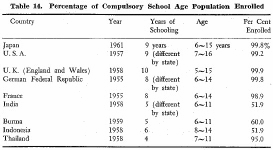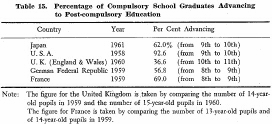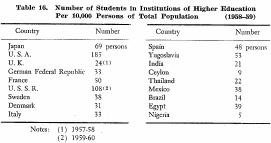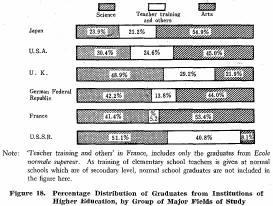| Home > Policy > White Paper, Notice, Announcement > White Paper > JAPAN'S GROWTH AND EDUCATION 1963 > CHAPTER |
||
In the preceding pages the historical relations between the quantitative development of education and various socio-economic factors in Japan have been considered. In this section the development of Japanese education will be compared with that of other countries.
Percentage of Compulsory School Attendance

The average length of compulsory education differs according to country and, in some countries(e.g. the U.S.A.), within individual countries. Table 14 shows both the average number of years of compulsory education and the average per cent of attendance in compulsory education in several selected countries. Compulsory education in Japan, as in such Western countries as the United States, the United Kingdom, the German Federal Republic and France, includes lower secondary education and attendance is nearly 100 per cent at the compulsory level.
On the other hand in Southeast Asian countries, such as India, Burma and Indonesia, as well as in the newly independent countries in Africa, compulsory education includes only a part of the elementary level and the percentage of attendance is still low.
Percentage Advancing to Post-compulsory Education Level

In Japan 62 per cent of the total lower secondary school graduates in March 1961 advanced to upper secondary schools. Table 15 shows the percentage of those advanced to secondary education after completing compulsory education in comparison with other selected countries.
The percentage of students completing compulsory education who enter upper secondary schools in Japan is lower than in the United States and France but is higher than in the United Kingdom and the German Federal Republic. The Japanese percentage includes students in part-time upper secondary schools while data for the other countries do not. The reason for the is that students in part-time upper secondary schools in Japan may, and usually do, complete the full upper-secondary school curriculum, and graduate therefrom. This is not true in the other countries.
The popular spread of secondary education is not measured by the numbers or percentage of youth of secondary age entering the secondary schools, but rather by the percentage of those who complete the secondary school curricula. In Japan there is a few problem of "drop-outs" at the upper secondary level. This is because, in Japan, school learning certificate or diploma has a strong influence over employment, and to give up school education without completing it causes a big handicap.
Spread of Higher Education
The extent of the spread of higher education in Japan and other selected countries is shown in the comparative chart, Figure 17, in terms of the percentage, which the enrollment is of the total population of the corresponding age.

Of the countries listed, Japan is surpassed only by the United States and the U.S.S.R. in the percentage of total population of higher education age actually enrolled in higher institutions. The United Kingdom, France and the German Federal Republic fall considerab1y below Japan on this measure.
The reasons for the disparities shown are complex, largely related
to socio-economic and political factors peculiar to each of the countries listed.
The superiority of the American educational system as evidenced by its relative
position on this measure, is largely a result of the long period of democratization
of education in this country, and of the extreme diversification of its industries
and its high level of production. In the case of the U.S.S.R., as higher education
has been intended from the beginning, for the training of workers, much effort
has been inserted to the expansion of higher and specialized education for the
progress of science and technology. Japan's position is largely the result of
the increasing democratization of education since World War ![]() and
the increasingly high technological level of its industries and its continued
high level of economic development.
and
the increasingly high technological level of its industries and its continued
high level of economic development.
In Table 16, as another comparative measure of the spread of higher education, the enrollment in institutions of higher education per 10,000 persons of the population is shown for a more extensive group of countries. The U.S.S.R. figure includes students receiving higher education by correspondence, as such students receive certification of credit equivalent to that received by full-time students upon graduation. If the students of correspondence education are excluded, the corresponding figure for the U.S.S.R. would be reduced from 108 to 64 students of higher education per 10,000 of the total population.

Japan ranks second or third, after the U.S.A. and possibly the U.S.S.R., among the 18 countries listed, on this measure.
Figure 18 shows the percentage distribution of graduates from higher education curricula grouped as science, liberal arts, and teacher training and others. This Figure shows that Japan had the lowest percentage of graduates from science curricula of all the countries listed.

In recent years, practically all nations have undertaken programs for the promotion of scientific research in all fields, but particularly in the physical sciences, and also for the identification of talented students and encouragement of their advanced education in the sciences, mathematics and foreign languages. In the United Kingdom, such programs have been in accelerated operation since 1945. In the U.S.A., extensive programs have been encouraged and financed under the National Defence Education Act of 1958. The U.S.S.R. has made vast efforts to increase the numbers of students in the fields of science, technology and teacher training. Japan has made much progress in these same areas and is continuing such efforts with almost complete public support.
| Back to Top | MEXT HOME |